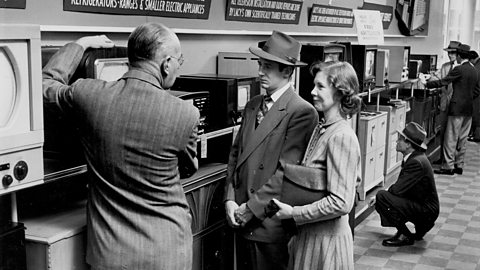Post-war affluence and consumerism
The 1950s saw rising wages and falling prices. These changes combined with increased demand, as rising birth rates caused population growth. As a result, the USA prospered.
Explore how World War Two changed America through animation and archive footage.
TrumanвҖҷs Fair Deal
Every segment of our population, and every individual, has a right to expect from his government a fair deal.
Vice President Harry Truman had taken over as president when Franklin D Roosevelt died in April 1945. He called his plan for American recovery after the war the Fair Deal. It was intended to continue to improve the lives of the American people and boost the economy in the same way that the New Deal had done in the 1930s.
Truman managed to increase the minimum wageThe lowest wage permitted by law. that had to be paid to American workers, as well as giving old age benefits to a further 10 million Americans and he began the work of replacing slumA run down area where people live in very poor conditions. However, CongressThe legislative body of the US government, made up of the Senate and the House of Representatives. rejected his proposals for increased civil rightsRights everyone is entitled to regardless of the colour of their skin, their beliefs, sexuality, gender or other personal characteristics. These rights could include the right to vote, or the right to a good education etc. for African Americans and improved health care for everyone.
Affluence
After the Great DepressionThe economic downturn that resulted in high unemployment following the 1929 Wall Street Crash. many Americans were reluctant to spend their wages as they were worried that they might lose their jobs again and end up without any money. However, the total value of the US economy had increased by 35 per cent between 1941 and 1945, and it continued to increase after the war.
As the economic situation improved many people became more affluentHaving a lot of money or owning a lot of things. They were increasingly comfortable with the idea of spending their money rather than saving it. In 1945, the average income of an American was twice that of somebody in Britain. By 1960 it was three times bigger.
Consumerism and consumer goods
As people began to feel more affluent, they began to spend more and more of their money on consumer goodsGoods that are used as ends in themselves and not for the production of other goods. Examples include vacuum cleaners, fridges and radios. and luxury items that made their lives more comfortable. Improved production techniques and technological advances, such as the development of the transistor, made electrical items such as radios, televisions and record players much cheaper to buy.

A popular consumer item during this time was the television. By 1960, 90 per cent of American homes had one. This coincided with an increase in leisure time as a result of automation in factories and technology in offices, such as computers. This meant that workers could now do more work in less time.
Advertising in newspapers and magazines, on television and on the radio convinced people to spend more and more money. Car sales increased from around 69,500 in 1945 to 6.7 million in 1950. This meant that increasing numbers of people could shop in out-of-town supermarkets and shopping malls. There were eight shopping malls in the USA in 1946 but over 4,000 by 1960.
By the 1950s, the USA made up 6 per cent of the worldвҖҷs population, made 66 per cent of all of the goods produced in the world, and bought 33 per cent of all of the goods produced in the world.
Buying on credit
With increasing wages and better job security as a result of the consumer cycleA cycle where as people spend more money, businesses make more money, and pay their workers more. As a result, peopleвҖҷs jobs become more secure, they spend more money and the cycle continues. people felt much happier about borrowing money to pay for things. This was because they were confident that they would be able to pay the loans back.
hire purchaseA method used to buy an asset in instalments whereby the asset only belongs to the person or business after the very last repayment., which involves buying an item on creditWhen something is bought on credit, it means the customer acquires an item immediately but permission is given for them to pay for it later. and paying for it in small amounts over a period of time, increased by 800 per cent between 1945 and 1957. This allowed people to buy more consumer goods than they would have been able to otherwise. The introduction of credit cards, such as Diners Club in 1950 and American Express in 1958, also made the purchase of consumer goods easier.
Impact of the Korean War
The Korean War between North and South Korea lasted from 1950 to 1953. The USA fought on the side of South Korea. This gave a new boost to the US industries that built weapons, and there was an increase in demand for steel, coal and other materials needed to make them. This meant more jobs in these industries as well as higher wages, which increased American affluence even further.
However, in the first stage of the war there was a rush to buy consumer goods, such as cars. This was because people thought these goods would be restricted or rationed like they had been during World War Two. As a result, there was a sharp rise in prices.